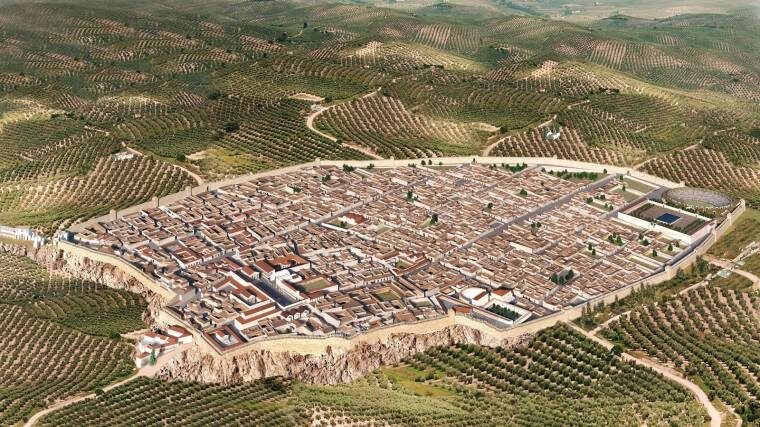
Along with the complete excavation of two houses — the House of the Garden and the House of Orion — the dig has yielded frescoes, murals, and mosaics of mythological figures in gorgeous colours, skeletons with stories still to be unravelled, coins, amulets, and show horses in the stable of a wealthy landowner.
The new finds are also sparking debate about Pompeii's tragic story. Just before Vesuvius erupted in A.D. 79 and buried the city under a mantle of ash and rock, a local worker scrawled an inscription on a wall. Along with a joke (roughly translated as "he ate too much"), he wrote the date: October 17. The discovery of this inscription may confirm the view that the eruption took place in October, and not August, as some scholars maintain.
Preserving Pompeii's past
These remarkable discoveries were not unearthed as part of a dig, but in the course of emergency maintenance of the site. From 2012 until last December, Pompeii was in the archaeological equivalent of an intensive care unit known as the Great Pompeii Project. Funded by the European Union at a cost of £88 million, the project was a response to UNESCO's call for urgent action to keep Pompeii off its World Heritage in Danger List.
Since the 1960s, the site had been ravaged by neglect, poor drainage, earthquakes, mass tourism, theft, and vandalism. By 2010, after heavy rains triggered the collapse of the emblematic Schola Armaturarum, used by gladiators to train before fights, Pompeii was falling apart. Just 10 of the city's buildings were open to the public compared with 64 in 1956, and over 70 percent of the site was closed to visitors.
The preservation efforts have been a success so far. Nearly 40 structures are now open to the public, including the Schola Armaturarum, in addition to those that have never been closed, such as the forum and surrounding buildings, theatres, and amphitheatre. According to Massimo Osanna, director of the Archeological Park of Pompeii, the Great Pompeii Project "secured the entire archaeological area, restored and reopened entire areas, buildings, and streets denied to the public for too long. Pompeii is now in incomparably better condition than in the past."
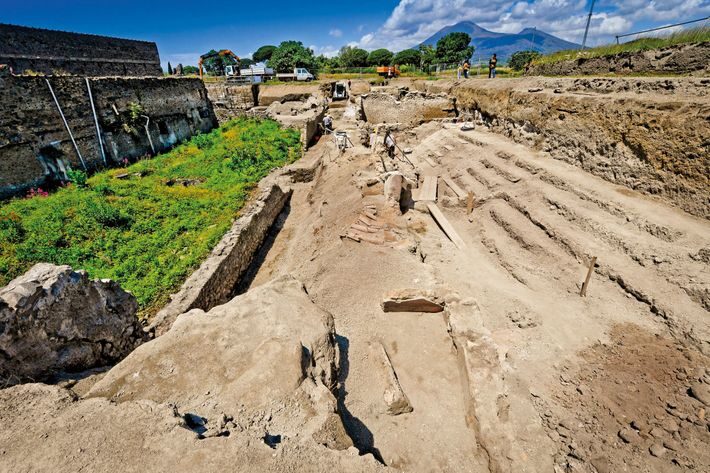
Unexplored territory
Since its discovery, Pompeii has been one of the longest continually excavated sites in the world. Despite all this work, about a third of Pompeii's 170 acres remain unexplored. Italian archaeologist Giuseppe Fiorelli led explorations for 12 years until 1875 and uncovered about a third of the city. Amedeo Maiuri, ran the site for about 40 years, until 1961, bringing another third to light. Scientifically rigorous, both men recognised that restoration and maintenance were sometimes more important than fresh discovery.
Among the many outstanding discoveries made at Pompeii earlier last century was the unearthing of a mausoleum at Porta Stabia, the city's southern gate. The marble tomb, built shortly before the volcano's eruption, has the longest funerary epigraph ever found — over 13 feet — revealing much about Pompeian life. Other famous finds including the Villa of the Mysteries, located in Pompeii's suburbs, was discovered in 1909 and completely excavated by 1929. It contains what Massimo Osanna called "the best preserved pictorial cycle of antiquity." The House of the Vettii, discovered and restored in 1894, is the first Pompeii domus to be found with all the frescoes and furnishings in situ.
Pompeii's many fine villas reflect the presence of wealthy Romans. Yet Pompeii also had a thriving agricultural and industrial economy. Archaeologists have found over 200 craft workshops, including tanners, textile makers, and bakers. The production of garum, a fish sauce, was a staple of the local economy. First-century Pompeii was a metropolitan place of some 15,000 people, with fast-food restaurants and a politically engaged populace.
The Great Pompeii Project has proven that Pompeii still has mysteries left to explore. Archaeologists are to deploy the latest techniques, including ground sensors, drones, CAT scans, and virtual reality, to continue making new finds, and protecting them, to shed light on the daily lives of the people living in Pompeii and bring them to life more vividly than ever.
Volcano's victims and survivors
Recent excavations have unearthed 12 more victims killed by the eruption of Vesuvius. A headless skeleton found in Region V was at first believed to have been decapitated by a massive stone block, but archaeologists later found his skull and determined that death was caused by asphyxiation due to pyroclastic flow — hot gas and rock fragments hurtling through the city at speeds of 50 miles an hour or more. Archaeologists also uncovered signs of survivors. Presumably made by those fleeing, cart wheel tracks were found in 2017 preserved near Porta Stabia, the city's southern gate.
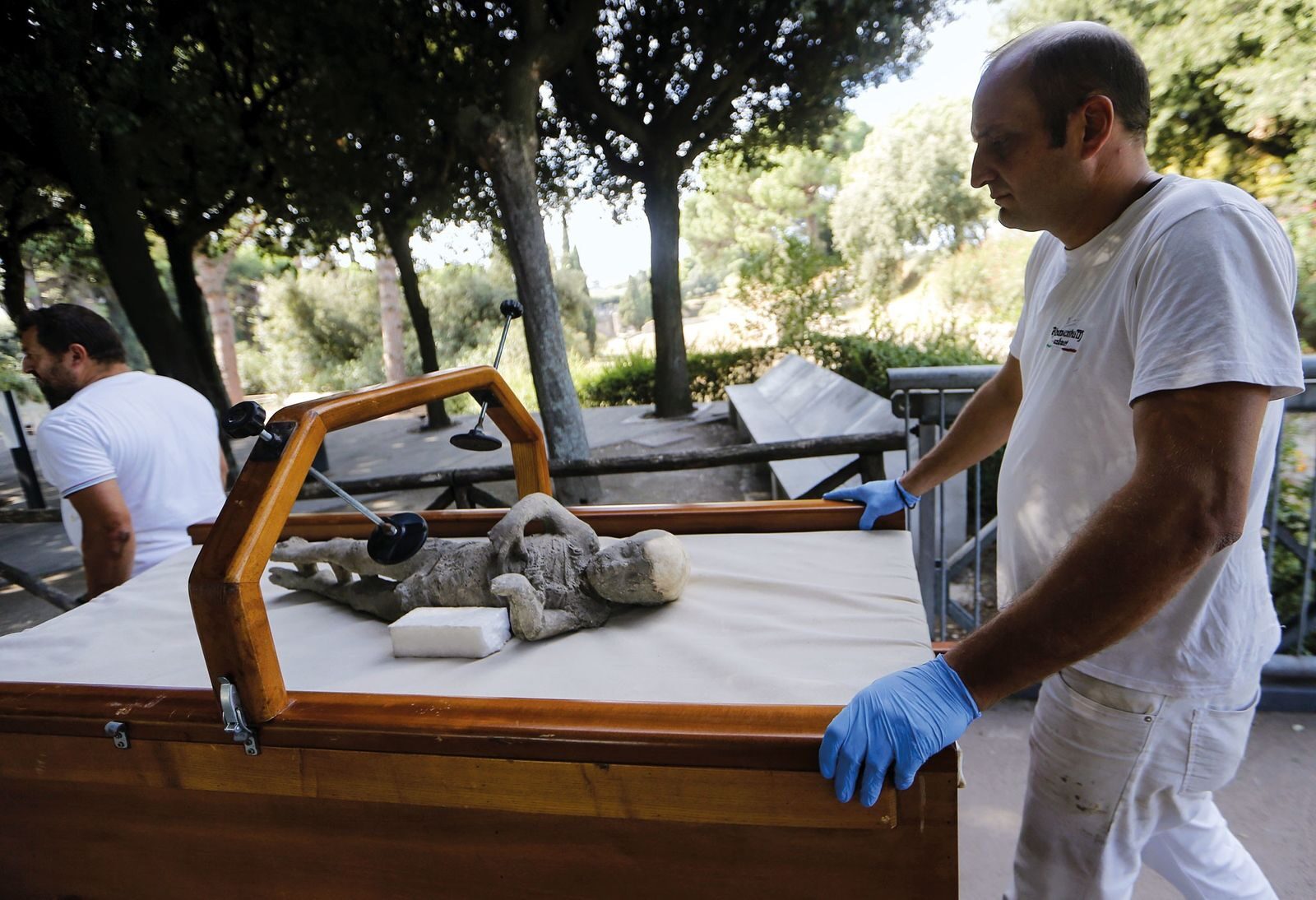
Date of destruction?
Historians have long believed that Vesuvius erupted on August 24, A.D. 79, based on a letter from Pliny the Younger in which he recounts the event as he witnessed it from the other side of the Bay of Naples, but a discovery from Region V challenges that traditional notion. Charcoal writing found on a wall of the House of the Garden includes a date — 16 days before the calends of November in the old Roman calendar style — which corresponds to October 17 in the modern calendar. Its presence suggests that the eruption must have happened soon after the graffiti was written because the delicate charcoal would not have lasted long in the open air. The volcanic ash protected and preserved it.
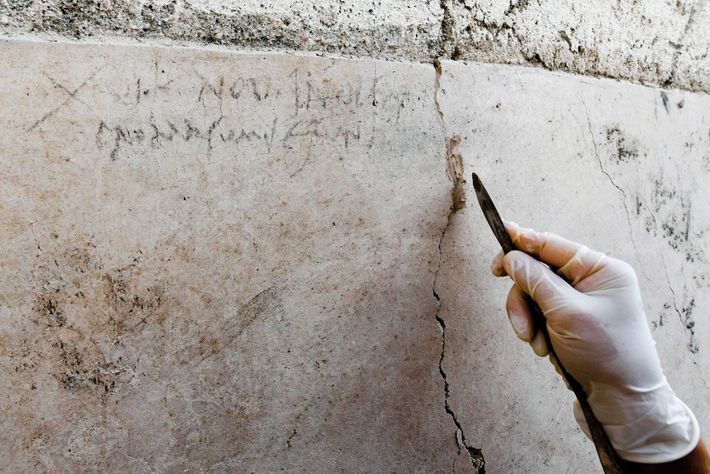
Horses and stables
Less than half a mile outside the northern walls of ancient Pompeii, in a suburb called Civita Giuliana, archaeologists found a stable with three horses preserved by the eruption. One of them allowed for the first ever plaster cast of a complete horse killed by Vesuvius. Separate from the Great Pompeii Project, this 2018 excavation was prompted by a police investigation. Grave robbers had built tunnels into the site to steal artifacts to sell on the black market. The illegal excavations damaged two of the horses and other artifacts, along with ancient walls and plasterwork, but one horse remained untouched.
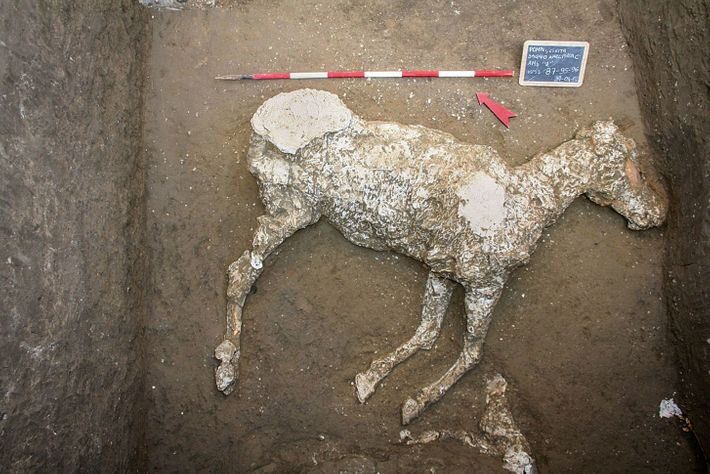
Leda and the swan
In a small bedroom in a house excavated in Region V's Via del Vesuvio, archaeologists came upon a rendering of Leda and the swan, one of the most spectacular finds of the Great Pompeii Project. The well-preserved fresco depicts the Greek myth of Leda being seduced by Zeus in the form of a swan; one of their children, the beautiful Helen, would launch a thousand ships to start the Trojan War. Unlike other Roman depictions of this story, Leda looks directly at the viewer, turning observers into voyeurs.
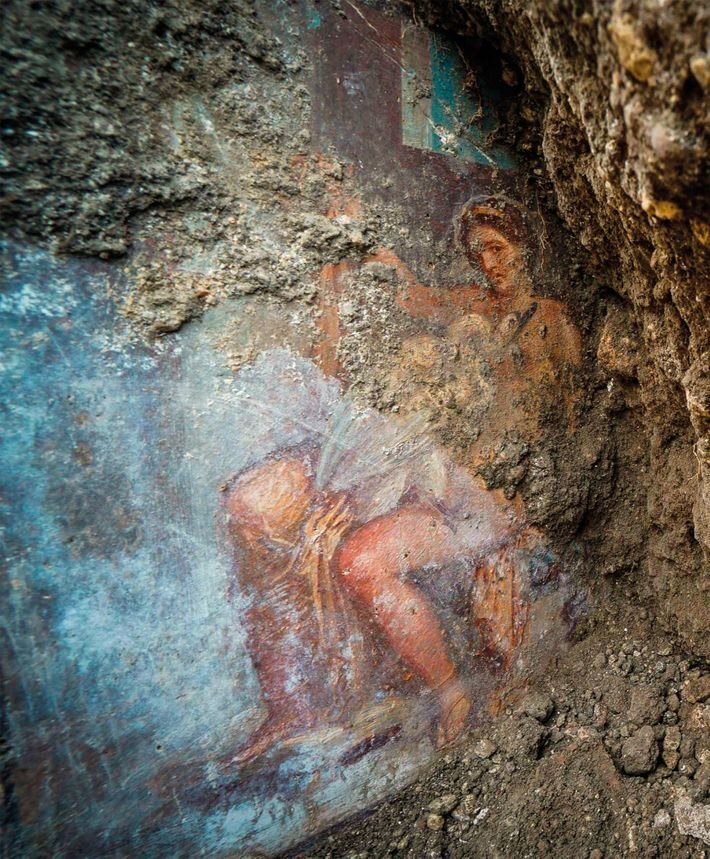
Fast food and frescoes
Excavations in 2018 to stabilise walls in northern Pompeii's Region V unearthed the Alley of the Balconies. This unique region of Pompeii revealed a mixing of social classes. The alley is a narrow street lined with grand houses, some of which feature a rare find — four large second-floor balconies, well preserved because they collapsed on a bed of lapilli, or soft pumice, from the volcano's eruption. One terrace still had amphorae, terra-cotta jars for wine and oil, laying on their sides, probably left outside to dry.
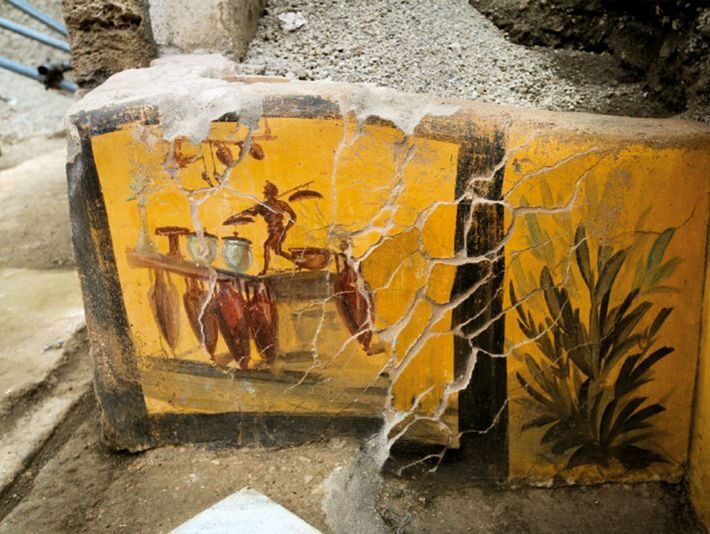
Domestic temples
One of the most distinctive features of a Pompeian house is the lararium, a shrine to the household gods. Called Lares, these deities protected the family, and statues of them were often placed in a special niche for worship. In 2018 archaeologists unearthed a semi-enclosed courtyard in Region V, with one of the finest examples of a lararium ever discovered in Pompeii. The niche for the shrine is flanked by painted twin images of Lares. Painted on the wall beneath the niche are two large serpents, symbolising prosperity and good luck, and a pedestal topped with food and offerings. On the floor rests a small stone altar that still bears traces of burnt offerings to ensure the goodwill of the Lares.
The space is decorated to resemble a magnificent garden. Birds flit among the trees, while a peacock seems to stroll along the ground, blending in with painted plants and real ones that once grew in a flower bed along the wall. A dynamic hunting scene was painted on a vibrant red wall. A massive black boar is being pursued by other animals, who are close to bearing down on it.
Political messaging
The alleys and walls of Pompeii were alive with inscriptions, most commonly political campaign "posters" and personal greetings. Technically, these posters are depinti (painted onto plaster), intended for a broad audience, while graffiti (scratched into plaster) were handwritten by anyone, usually names and greetings to friends.
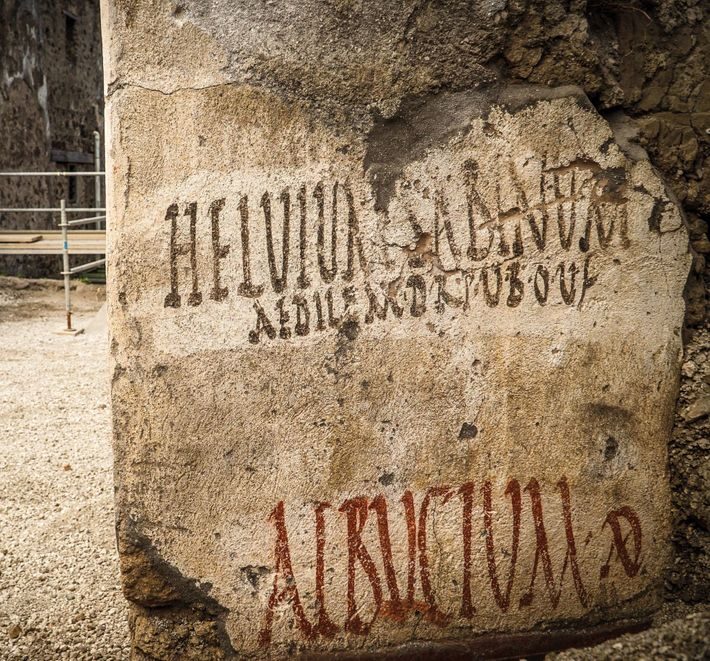
Generally, personalised recommendations for candidates emphasised the person as "a good man" or "man of integrity." But one stands out as a particularly interesting insight into the persuasion tactics used in Pompeii: "I ask that you vote for Gaius Julius Polybius for aedile. He brings good bread." Since Polybius has been identified elsewhere and is not a baker, Benefiel thinks he probably paid for free bread distribution to win over voters.
House of Orion
First excavated in the 18th century, a domus on the Via di Nola, the House of Jupiter, was named for a small painting of the Roman god found in the home's lararium. The most recent Pompeii excavations have returned to this domus to obtain a fuller picture of its architecture, decor, and history. In 2018 archaeologists uncovered a stunning and highly unusual mosaic of an enigmatic mythological episode. The central figure was later identified as Orion.
Following more studies, the researchers came to the conclusion that it formed part of a separate house, lying adjacent to the House of Jupiter, now called the House of Orion. The mosaic and other finds in this home have provided new insight into the upper echelon of Pompeian society. The owner of this house was not only wealthy but cultured. The atrium, for example, features old-fashioned First style, while the bedrooms are decorated in the contemporary Third or Fourth style. Archaeologists contend that the owner's choices intended to show off his appreciation for both the classic and the new.
Bangles, baubles, and beads
In the House of the Garden, situated in Region V, the remains of a group of people, including women and children, were found huddled together in a room. One of them might have been the owner of a wondrous wooden box filled with charms, ornaments, and figurines. The collection was found among the charred remains of the box and its bronze hinges.
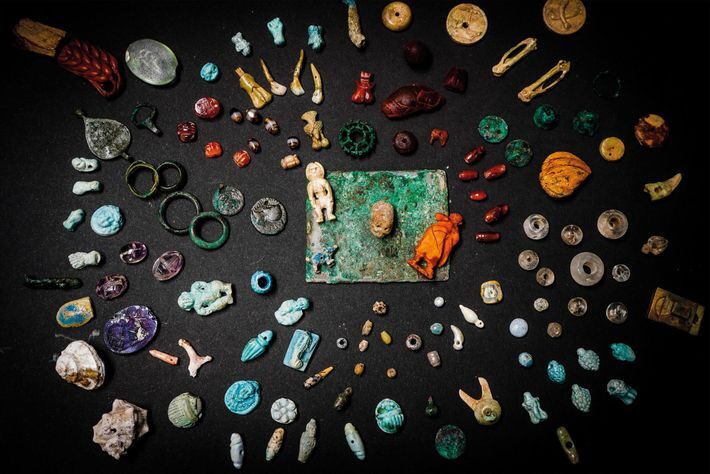
Ruben Montoya is a researcher in the Archaeology and Ancient History Department of the University of Leicester, England.
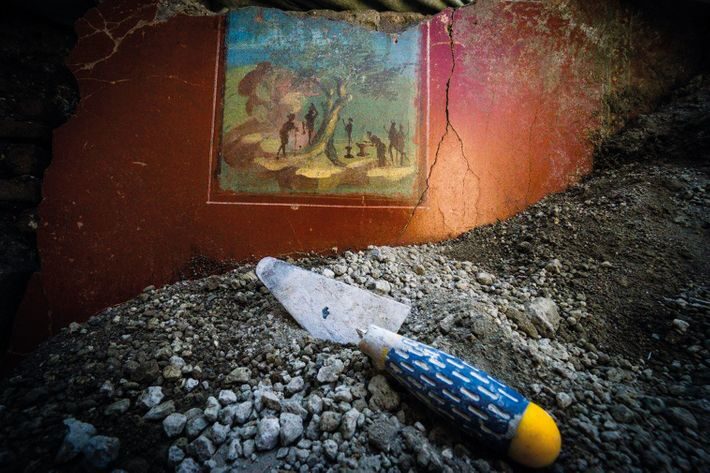



R.C.